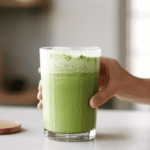For centuries, matcha has been a beloved beverage in Japanese culture, used in traditional tea ceremonies and daily wellness practices. Recently, it has exploded in popularity worldwide, showing up in everything from lattes and smoothies to desserts and skincare products. Yet, if you’ve never tried it before, you might be asking: what does matcha tea taste like?
The flavor of matcha is unlike most other teas, making it an exciting but sometimes surprising experience for first-time drinkers. This guide will walk you through the unique taste profile of matcha, explain how preparation affects flavor, and help you understand what to expect whether you’re sipping pure ceremonial grade tea or enjoying a sweet, creamy latte.
Understanding Matcha: More Than Just Green Tea
Before diving into taste, it’s important to clarify what makes matcha different. Unlike regular green tea leaves, which are steeped and discarded, matcha comes in the form of finely ground powder made from shade-grown tea leaves. This means you’re actually drinking the entire leaf, giving matcha its rich flavor, vibrant green color, and concentrated nutritional profile.
This process intensifies everything—both the health benefits and the taste. So when someone asks what does matcha green tea taste like, the answer is closely tied to its unique preparation.
The Core Flavor: What Does Matcha Taste Like?
To a first-time drinker, matcha can taste earthy, slightly grassy, and even a bit vegetal. The closest comparison might be spinach, but with a smoother, richer undertone. There’s also a touch of natural sweetness and umami—a savory depth that’s often described as “brothy” or “creamy” despite the absence of dairy.
-
Earthy & grassy notes: The initial sip might remind you of fresh-cut grass or leafy greens.
-
Bitterness: High-quality matcha has a mild bitterness similar to dark chocolate or black coffee, but not overwhelming.
-
Natural sweetness: Shade-growing the tea leaves boosts L-theanine and chlorophyll, which balance bitterness with a subtle sweet finish.
-
Umami richness: A savory taste often found in Japanese cuisine, giving matcha its “full-bodied” and satisfying quality.
If you’re new, the complexity may take a few sips to truly appreciate, but many people find the taste refreshing and energizing once accustomed to it.
What Does Matcha Tea Taste Like vs. Other Green Teas?
If you’ve had traditional green tea, you might expect matcha to taste similar, but the differences are striking. Regular green tea, like sencha, is milder and often a little more astringent since you’re only drinking the infused liquid.
With matcha, you’re consuming the entire leaf, which naturally creates a bolder, more concentrated flavor. Imagine green tea amplified—to some, it feels more vegetal and robust, while others notice creaminess that’s absent in regular brews.
Breaking It Down: What Does Matcha Latte Taste Like?
For many first-timers, the introduction to matcha comes not in its pure form but in the form of a latte. This is one of the most beginner-friendly ways to experience matcha’s flavor. So what does a matcha latte taste like?
When combined with milk (dairy or plant-based), matcha’s earthiness softens significantly. The natural creaminess of milk balances the grassy notes and brings out the subtle sweetness. If sweetener is added, the flavor transforms into something indulgent, almost like a dessert, without losing matcha’s signature green, refreshing undertone.
-
Matcha latte with dairy milk: Creamy, rich, with mellowed vegetal notes.
-
Matcha latte with oat or almond milk: Slightly nutty, with a smoother finish.
-
Sweetened matcha latte: Perfect for beginners—removes most bitter edges while highlighting sweetness and umami.
In short, if pure matcha feels like sushi-grade seaweed and spinach, a latte feels like a comforting, slightly sweet green cream—familiar yet new.
First Sip Reactions: What to Expect
Your first sip of matcha tea might surprise you—it’s not like black tea, coffee, or regular green tea. Some people find it incredibly refreshing, while others need time to acquire the taste.
Common first impressions include:
-
“It tastes healthy.”
-
“It’s grassy but smooth.”
-
“Almost like vegetables in a cup.”
-
“Kind of like seaweed, but creamier.”
If your matcha tastes extremely bitter or unpleasant, it may be due to using a lower grade of powder (culinary instead of ceremonial) or improper preparation (such as overheating the water).
Quality Matters: Ceremonial Grade vs. Culinary Grade
When asking what does matcha green tea taste like, the answer depends heavily on quality.
-
Ceremonial Grade Matcha: The highest quality, traditionally used for Japanese tea ceremonies. It has a delicate, smooth, and naturally sweet flavor with very little bitterness. First-time drinkers often find this more approachable.
-
Culinary Grade Matcha: Designed for recipes, smoothies, and baking. It has a stronger, more robust flavor profile, often with more bitterness, which can be overwhelming if consumed straight as tea.
If your first taste of matcha comes from a latte or culinary-grade mix, don’t assume that’s how all matcha tastes. Higher quality ceremonial matcha is generally much smoother.
The Science Behind Matcha’s Taste
Matcha’s unique profile is influenced by two main compounds:
-
L-Theanine: An amino acid that gives matcha its umami richness and contributes to its calming, focused energy.
-
Catechins (EGCG): Powerful antioxidants that give matcha astringency and a slightly bitter edge.
Together, they create a balanced complexity—making matcha at once earthy, savory, and subtly sweet.
How Preparation Changes the Flavor
If you want the best first-time matcha experience, preparation matters:
-
Water temperature: Using hot water above 175°F (80°C) can make your matcha taste bitter. Use slightly cooler water for a smoother drink.
-
Whisking: Matcha should be whisked until frothy to enhance mouthfeel and soften grassy notes.
-
Serving style: Straight matcha has the purest flavor, while lattes tone it down. Adding honey or vanilla further sweetens the taste.
Acquired Taste or Immediate Love?
For some, matcha is love at first sip. For others, it takes a few tries to warm up to the flavor. Think of it like coffee or red wine—complex beverages that often require developing a palate. Once you adjust, you may find yourself craving that earthy, umami-rich depth only matcha provides.
Beyond Taste: Why People Stick to Matcha
Even if the taste feels unusual at first, many people keep drinking matcha because of the way it makes them feel. The caffeine content offers steady, calm alertness rather than a jittery coffee buzz. Combined with L-theanine, it creates what’s often called a “zen energy.”
On top of that, matcha is rich in antioxidants, supports metabolism, and promotes overall wellness—which makes the flavor part of a bigger lifestyle choice.
Where to Try High-Quality Matcha
If you’re ready to explore matcha, sourcing matters. Many cheap versions on the market are dull in color and harsh in taste. Look for a bright, vibrant green powder, preferably ceremonial grade. Trusted retailers and even some global tea brands sell direct online. For a deeper dive into its origins and benefits, you can explore Japan’s official tea culture resources for authentic information.
Read More: Xiaomi 17 vs iPhone 17: Aggressive Pricing and Snapdragon 8 Elite Gen 5 Raise the Stakes in China
Final Thoughts
So, what does matcha tea taste like to a first-time drinker? Expect a vibrant experience: grassy and vegetal, yet smooth and naturally sweet with a savory umami finish. In latte form, it becomes creamy, comforting, and accessible even to newcomers.
Whether you end up loving it instantly or need some time to adjust, matcha offers a taste unlike any other beverage—rich in tradition, culture, and health benefits. And once you acquire the flavor, it quickly shifts from curiosity to daily ritual.









